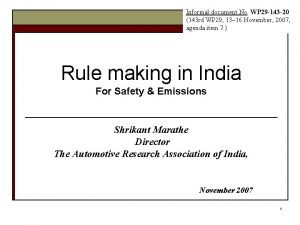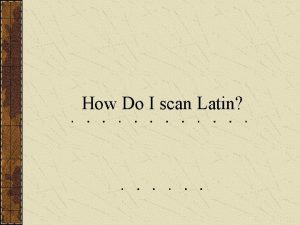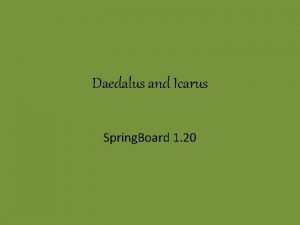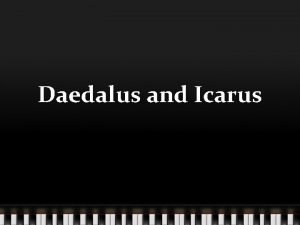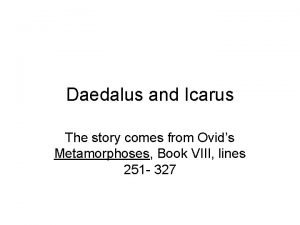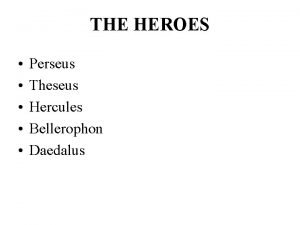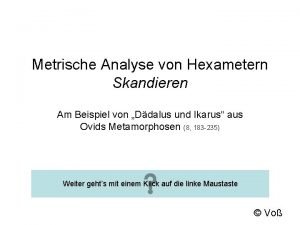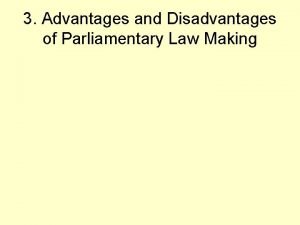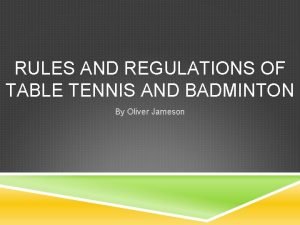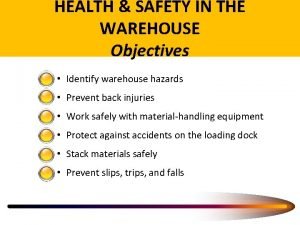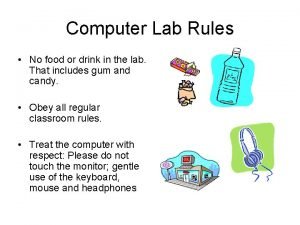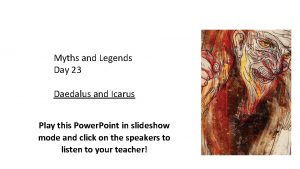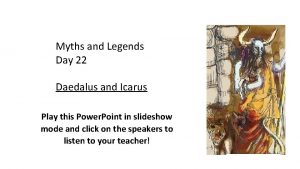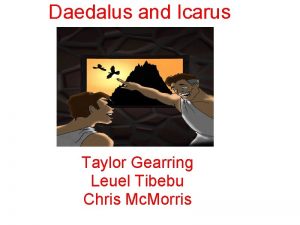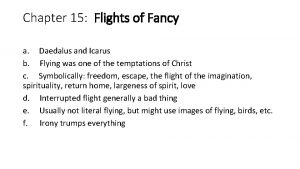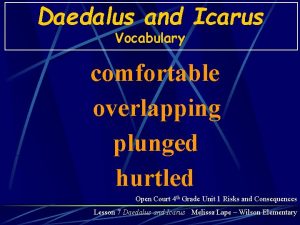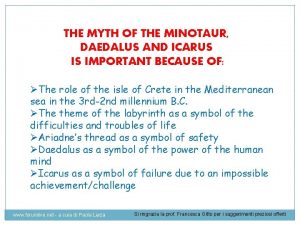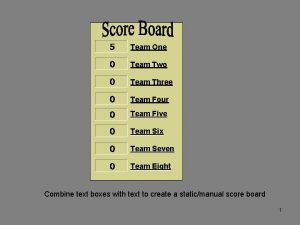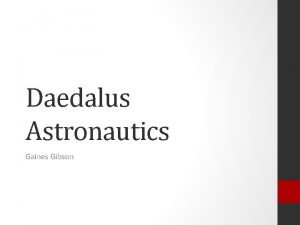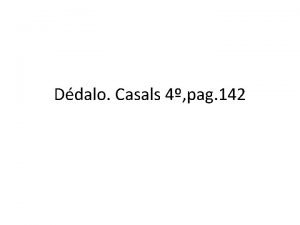Standards and Regulations Team Daedalus Standards and Regulations
























- Slides: 24

Standards and Regulations Team Daedalus

Standards and Regulations 1. FCC – Part 15 2. Advanced Encryption Standard • • • Description Prescriptions and Standards Application to Project

FCC Part 15 – What is it? • Federal Communications Commission (FCC) has rules to limit the interference to licensed transmitters by lowpower, non-licensed transmitters. • These non-licensed transmitters must comply with the regulations of Part 15 of the FCC rules.

Applicable Product and Market

Unlicensed Operation • Certain bands within the RF spectrum are available for “unlicensed” operation (ISM) • The manufacturer of a product designed for “unlicensed” operation is not exempt from testing and/or certification • Both the transmitter and receiver must be tested by a qualified testing laboratory • Once the necessary approvals are received, the end user can then operate the product without further obligation or licensing

902 -928 MHz band • XBee modules come under Part 15. 247 for spread spectrum radios - Frequency Hopping (FHSS) • Only restrictions on output power, harmonic levels and bandwidth • No restrictions on application, transmission duration, or how often a radio transmits • Popular for data, video and audio

902 -928 MHz band - Advantages • Very little restrictions on the type or duration of analog or digital data transferred • Higher output power allows the potential for much longer transmission distances • Higher frequencies mean shorter wavelength • This allows a ¼ wave antenna at 900 MHz to be less than 3. 25” in length compared to 6. 5” at 433 Mhz • Some antennas in this band are < 0. 5” in length w/o sacrificing gain

Frequency Hopping • Rather than transmitting at a certain fixed frequency or channel, a technique of hopping between different channels is utilized to facilitate multiple access. This also helps in decreasing interference. Th = Hop Duration B = Bandwidth large enough to include most of the power in a signal pulse W = Bandwidth of hopping band Reference: http: //www. globalspec. com/reference/74106/203279/ch apter-3 -frequency-hopping-systems

Prescription and Standards • Operational Requirement ▫ § 15. 247 Section a(1)(i) For frequency hopping systems operating in the 902– 928 MHz band: �If the 20 d. B bandwidth of the hopping channel is less than 250 k. Hz, the system shall use at least 50 hopping frequencies and the average time of occupancy on any frequency shall not be greater than 0. 4 seconds within a 20 second period �If the 20 d. B bandwidth of the hopping channel is 250 k. Hz or greater, the system shall use at least 25 hopping frequencies and the average time of occupancy on any frequency shall not be greater than 0. 4 seconds within a 10 second period.

Prescription and Standards • Operational Requirement ▫ § 15. 247 Section b(2) For frequency hopping systems operating in the 902– 928 MHz band : � 1 watt for systems employing at least 50 hopping channels � 0. 25 watts for systems employing less than 50 hopping channels, but at least 25 hopping channels

FCC – Part 15 • Prescriptions and standards Antenna Requirement Ø Changing the antenna on a transmitter can significantly increase, or decrease, the strength of the signal that is ultimately transmitted Ø Each Part 15 transmitter must be designed to ensure that no type of antenna can be used with it other than the one used to demonstrate compliance with the technical standards

FCC – Part 15 • Prescriptions and standards Conducted emission limits Ø Part 15 transmitters that obtain power from the electrical power lines are subject to conducted emission standards that limit the amount of radio frequency energy they can conduct back onto these lines in the band 450 k. Hz - 30 MHz. This limit is 250 microvolts.

FCC – Part 15 • Prescriptions and standards Radiated Emission Limits Type of detector used to measure emissions: 1) average with a peak limit, "A" 2) quasi-peak, "Q"

International regulations • Canada and Brazil are almost the same as the United States • 433. 92 MHz is legal in most countries • Japan, China and India are notable exceptions • 900 MHz band is not the same in many countries • Illegal in Europe, need to go to 862 -870 MHz • Brazil, Australia and NZ have restricted gaps within this band • 2. 4 GHz band is globally accepted

FCC – Part 15 : Application to our project • XBee from Digi allow designers to move across both the 2. 4 GHz and 900 MHz bands using the 802. 15. 4 protocol, with the 900 MHz versions for longer range or environments that need more immunity to interference. • These embedded RF modules have a common footprint shared by multiple platforms, including multipoint and Zig. Bee/Mesh topologies with both 2. 4 GHz and 900 MHz solutions. Interference is a key reason for using modules - • Provide protection against EMI interference through shielding • Optimized antenna path designs to reduce the interference from the rest of the electronics and external sources

FCC – Part 15 : Application to our project • • • XBee 900 modules use FHSS Cyclic redundancy checking (CRC) is used to maintain the integrity of the data 128 -bit Advanced Encryption Standard CRC check implemented in the message datagram Oculus Prime equipped with XBee 900 module for V 2 V communication

Advanced Encryption Standard (AES)

AES • What is it? Ø Computer Security Standard approved by Federal Information Processing Standards (FIPS) that can be used to protect electronic data. Ø The AES algorithm is capable of using cryptographic keys of 128, 192, and 256 bits to encrypt and decrypt data in blocks of 128 bits. Ø It is also included in the ISO/IEC 18033 -3 standard which specifies block ciphers for the purpose of data confidentiality.

AES • What is it? AES is based on the Rijndael algorithm, which is a symmetric iterated block cipher. The block length is 128 bits and key lengths can be 128, 192, or 256 bits. Data 128 128 AES Key Ciphered Data

AES • Applicable product or market Ø The algorithm specified in this standard may be implemented in software, firmware, hardware, or any combination thereof. Ø Used by Federal departments for information that requires cryptographic protection. Ø Successful use by the U. S. government led to widespread use in the private sector, leading AES to become the most popular algorithm used in symmetric key cryptography

AES • Main prescriptions and standards Ø Variations of Rijndael that can operate on block sizes larger than 128 bits are not included in the actual standard. Ø Certain cryptographic devices and technical data regarding them are subject to Federal export controls. Ø Exports of cryptographic modules implementing this standard and technical data regarding them must comply with Federal regulations and be licensed by the Bureau of Export Administration of the U. S. Department of Commerce.

AES • Application to our project Ø XBee Digimesh Pro 900 adapter supports 128 -bit AES encryption Ø Setting an identical 16 byte key network security key value on all devices allows exchange of encrypted data through the network Ø These features are accessed via AT Commands (Hayes Command Set)

References • https: //transition. fcc. gov/Bureaus/Engineering_Technology/Docu ments/bulletins/oet 63 rev. pdf • https: //apps. fcc. gov/kdb/Get. Attachment. html? id=QRSnt%2 BM%2 F e%2 BNFOLVll. OMyp. Q%3 D%3 D • http: //csrc. nist. gov/publications/fips 197/fips-197. pdf • https: //www. youtube. com/watch? v=MK 0 Srx. BC 1 xs

Thank you! Questions?
 Automotive regulations and standards
Automotive regulations and standards Food safety regulations and standards
Food safety regulations and standards Going native project management
Going native project management Team spirit becomes team infatuation
Team spirit becomes team infatuation The white team cheers for the blue team, just like
The white team cheers for the blue team, just like What is elision
What is elision Characterization of daedalus and icarus
Characterization of daedalus and icarus Daedalus and icarus plot diagram
Daedalus and icarus plot diagram Daedalus and icarus ovid translation
Daedalus and icarus ovid translation The myth of daedalus and icarus setting
The myth of daedalus and icarus setting Ovid metamorphoses icarus
Ovid metamorphoses icarus Theseus
Theseus Beispiel hexameter
Beispiel hexameter Diary of daedalus
Diary of daedalus Factors necessary for appropriate service standards
Factors necessary for appropriate service standards Disadvantages of act of parliament
Disadvantages of act of parliament Health and safety regulations in engineering
Health and safety regulations in engineering Food safety standards
Food safety standards Six pack health and safety regulations
Six pack health and safety regulations Bwf rules and regulations
Bwf rules and regulations Class rules and regulations
Class rules and regulations Warehouse health and safety requirements
Warehouse health and safety requirements No food or drink in computer lab
No food or drink in computer lab Child care facility rules and regulations answers
Child care facility rules and regulations answers Why do we have hunting laws and regulations
Why do we have hunting laws and regulations
